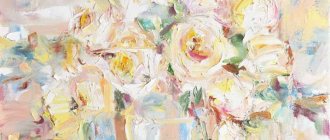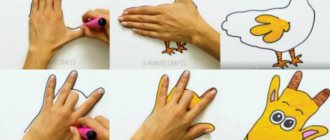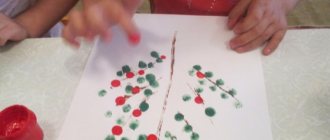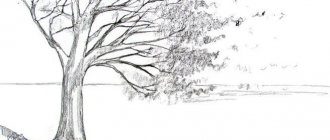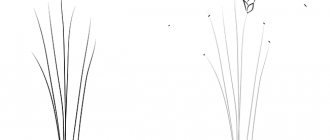Child development through drawing
The benefits for children from such creativity are enormous: fine motor skills develop, which in turn affects the child’s speech and memory.
When painting with finger paints, the child’s nervous system also develops, he learns to sit and walk correctly. By painting with their fingers, children better perceive colors and see the boundaries of their work. In the process of creativity, you can study colors, shapes, counting, paint animals and various objects that you will introduce your baby to.
Let's paint with our fingers!
Even for the youngest children, drawing can become one of the most favorite and useful activities. Children aged 1-2 years cannot yet depict objects. Besides, they are so fidgety! Therefore, the most accessible way to draw for such kids is with their fingers. And really, what could be simpler - dip your finger in the paint and paint... Even a child who is just beginning to draw can produce very beautiful works. It is difficult to spoil a picture in which night stars are poked in random order with your finger or red rowan berries are scattered on the ground for hungry birds.
If creative abilities remain unclaimed, then emotional depression accumulates over the years. Drawing helps to release accumulated creative energy and express your “I”.
Recently, children under the age of one year are being taught drawing more and more often. The youngest artists are six months old. “Why so early?” - many are surprised.
M. V. Gmoshinskaya - Candidate of Medical Sciences, pediatrician, author of a method for teaching drawing to children in the first year of life - believes that it is necessary to start as early as possible.
Drawing helps to establish creative and emotional contact between mother and child, develop attention, memory and thinking through artistic methods. In addition, in the process of creative work, sensory, fine motor skills, and color perception occur. “Unlike all proven methods, we do not show the baby “how to” and “how to do it right,” but rely entirely on his intuition, imagination, desire and even whim,” writes Gmoszynska.
Little artists learn to choose and mix colors from the palette, and they do it themselves. At first, babies simply draw with their fingers, a little later with their palms, and after a year - with brushes. The result depends on the artist’s mood, his “artistic experience,” as well as the mood of those around him.
Drawing at any age is great fun. Unfortunately, most of us almost never draw or do it extremely rarely. By doing this we are greatly impoverishing ourselves. Maybe we should have started drawing earlier too...
Art teachers say that at the age of 4-5, some children are afraid of a white sheet of paper. The teacher has to draw some kind of “squiggle” on the sheet so that the child decides to start his drawing. But with children who started drawing at about a year old, there is never a fear of a blank sheet of paper.
Unconventional drawing techniques. Finger painting. Journey to the Land of Imagination.
Finger painting
Hand drawing is one of the most ancient painting techniques! It develops creativity at any age.
Finger painting helps to release pent-up creative energy and express your “I.”
A lot of good research has now been written about the benefits of such activities and their impact on the development of a child’s personality. The emotional and bodily (physical) development of children is accelerated, the consequences of birth stress and illness are eliminated, fine motor skills of both hands develop perfectly, speech development accelerates and becomes more complex, work and volitional qualities are cultivated, a sense of beauty and self-esteem is cultivated, ways of conveying the beauty of the surrounding world are learned and much more. Psychologists all over the world recognize the calming effect of hand drawing.
“Finger painting” is “a way of conveying emotions, feelings and states that come from the depths of a person’s heart through direct contact of the fingertips with paints and paper.” And what is most valuable is that spontaneous painting does not require the ability to draw; there is only a non-judgmental perception of what is drawn (“the heart is at the tips of the fingers”).
The classes are so exciting that children and adults themselves do not notice how they are involved in the therapy process. There is a process of transformation of negative thoughts and emotions into creative feelings. These feelings are reflected in the painting. The therapeutic effect is observed not only at the moment of creating the picture, but also subsequently, being a powerful positive dominant.
The tasks of such visual activities
- instill in children an interest in unconventional drawing techniques - finger painting;
- develop children's creative imagination and fantasy;
- cultivate accuracy in work, teach how to finish a job;
- cultivate attention, observation and an aesthetic attitude to reality;
- learn to sit at the table correctly, hold your body and arms correctly:
- teach drawing by blotting with fingertips, phalanges, fist, palm, finishing the image by drawing details;
- learn to draw straight lines from top to bottom, from left to right, intersect them, draw curved lines, connect straight and curved lines, and also close them; teach children to depict objects of round, rectangular and triangular shapes; combine depicted objects into a composition;
— learn how to independently embody your own ideas in a drawing;
— teach children to distinguish, name and use colors in their work /red, blue, green, yellow, brown, black, white/, to know their shades /pink, blue, gray/.
About tasty and tasteless colors
The first thing your six-month-old aspiring artist will try to do is put paint in his mouth. This is completely natural for a child at this age. The most common reaction of parents is to limit the movement of their hands and tell the child constant “no”. Unfortunately, such actions exclude the free activity of the baby. In this case, the whole point of the drawing process is lost.
Of course, any paint is an absolutely inedible thing, and you need to remember this! You can stop your child from eating paints in this way: add a solution of Epsom salts or mustard to the paints. The child will understand: if it is “bitter”, it means “impossible”!
It is worth noting that both gouache and finger paints themselves also taste quite unpleasant, and it is unlikely that the child will want to try them again. So don't worry too much if he licks his painted finger or drawing.
Finger paints for kids
Finger paints are great for little ones.
- They can be given to a baby from about six months of age.
- Such paints are specially made for little ones and they do not contain harmful and toxic ingredients, they are made using food coloring, because little children put everything in their mouth and taste it.
- To prevent children from doing this, they usually add salt or another ingredient to the paints, after trying which the child will no longer want to repeat it.
- Finger paints can be easily washed off any surface, washed off from a child’s skin, and washed off from clothes.
Characteristics of finger paints
Child psychologists are sure that the sooner a child starts drawing, the smarter he will grow up. Until the baby has learned to hold brushes and pencils in his hands, finger paints are the best option. In addition, felt-tip pens, colored pencils, watercolors and gouache contain unsafe substances, and it is very difficult to remove traces of them from clothes and furniture.
Organization of the process of painting with finger paints
The drawing process itself is very exciting, so don’t forget about the precautions:
- dress your child in clothes that you don't mind getting dirty
- put on a bib or apron, there are special aprons for creative activities
- use a large sheet of paper, preferably Whatman paper or a piece of wallpaper, so as not to limit the child
- if you will draw on the floor, put oilcloth underneath
- transfer some of the paint you will use to other containers so that the child does not use all the paint at once, which is exactly what he will do if you give him the whole jar; can be transferred into lids or toy dishes
- prepare wet wipes or a wet cloth
It is better to start drawing when the child is in a good mood, so that he associates drawing only with positive emotions.
How to prepare a place for drawing?
- Watercolor paints are pre-diluted with water, creating a paste-like mass.
You cannot take materials with an expired expiration date for children's art lessons. They can cause allergic reactions in a child!
- It is better to pour the paint into saucers. It is difficult for a child to carefully pick up the required amount of coloring composition with his finger. It is much easier for babies to place their palm completely in a flat container.
- It’s good if there is a small vessel with warm water nearby. It allows your child to wash their hands when the color changes.
| The baby should not be left alone while drawing., otherwise he will definitely taste all the colors. The same applies to art lessons using semolina. During classes, you need to make sure that the child does not accidentally inhale semolina . While drawing, infants and one-year-old children enjoy tapping and clapping their palms on the surface to be painted. It is useless to expect a child to be able to engage in creative activities without getting their clothes dirty. Apart from the artist himself, everything within a one-meter radius will be painted, including his parents. Therefore, it is better to immediately allocate a place for studying, which will then be easy to clean . An oilcloth-covered floor is ideal for drawing with children aged 1 to 3 years. |
The first lessons are conducted like this:
- To begin with, you can give your child a few flowers. 3-4 main ones are enough.
- A small album sheet of paper is completely unsuitable for drawing with your palms. Here you will need a large sheet of Whatman paper or a piece of wallpaper.
- The child should be dressed in clothes that you don’t mind, or, if the room is warm enough, stripped down to panties. The young artist will definitely get dirty and try to depict something on himself.
A child’s first steps in art will resemble paintings by abstract artists.
There is no point in asking your child to complete certain tasks. He will not be able to draw accurately, because he does not yet control his own hands well enough. At the age of one to two years, a child can draw with his fingers on semolina scattered on a tray . The material for drawing can be pre-tinted and scattered into different jars. Before class, the cereal is poured out in small slides on different edges of the tray, and the child is asked to mix it like sand with his palms. Then run your fingers along the resulting multi-colored surface, leaving a mark. Invite the child to repeat the action.
With a child over 2 years old, playing with visual aids can be a little more complicated.
At the beginning of the lesson, the plane is covered with unpainted material. Then the mother shows the child how to draw lines with her fingers, and then with a stream of colored semolina. For this purpose, colored cereals are poured into rolled paper bags , in which a small hole is left at the bottom.
You can paint with children using any available means:
- Crumpled paper.
- Toothbrushes.
- Natural material (leaves, twigs, blades of grass).
- Pieces of fur.
- Cotton buds.
- Scraps of fabric.
One-year-old children are not able to draw perfectly even geometric shapes and complex objects. A child's drawing consists of a set of dashes - lines, scribbles and spots.
The more often a child draws, the more complex and interesting his work becomes.
Precautions when finger painting with children from one to three years old
You can only draw with kids who taste everything using paints that are safe for their health.
How to create with your fingers
Fingerprints resemble a brush stroke. Finger and palm typing can be used as a basis for creating various characters. Before starting work, the little ones are shown on a sheet of paper how to put dots and make lines. The baby tries to touch the paint with the tip of his finger.
Note! To change the color of the dye, the child will need to wash his finger in water and wipe it.
Creative work in non-traditional techniques can have any topic. Many finger painting ideas for children can be found in the world around us. You can come up with a variety of ideas for such work. For the youngest children - a yellow round chicken, red berries and so on.
When kids have practiced poking small areas with their fingers and filling them evenly, you can give them a more difficult task:
- draw large objects with your fingers;
- lay the prints along the steep curl.
A difficult task for children is to arrange their fingerprints in a circle from the center (this is how the spots on the tail of a turkey or peacock are located). This method can be used to decorate any round object, starting from the center and moving in a circle to the edges of the circle.
Note ! Older children are interested in more complex drawings.
To get a larger print, they press their finger to the surface of a sheet of paper and roll it over. Next you need to figure out what you can turn this resulting oval silhouette into. Using a felt-tip pen or pencil, they will complete the color masterpiece to whatever their imagination tells them - seasons, flowers, funny animals and many other funny images.
Drawing on the theme “Autumn”
Ideas for finger and palm painting
Children know how to see beauty. Palm printing is one of the favorite lessons of preschoolers, which takes them into the world of bright and amazing images. This exciting process is like a fun game - children are liberated and reveal their creative potential.
Non-traditional drawing lessons help to achieve a high artistic understanding, develop a sense of color and composition, the transition of one shade to another.
The technique of the work process is simple: the child dips his hands in paint or paints them with a brush, and then leaves a print on a piece of paper.
Note ! Different groups of children's institutions use different drawing techniques: techniques for adding details, the level of complexity of compositions, artistic creation of entire multi-color paintings with fingers.
Using the large stroke technique you can create beautiful landscapes. With your fingers it is easy to make not only prints, but also smeared lines (for example, hedgehog needles).
Blurred lines
The branches of the Christmas tree are obtained by drawing your fingers on both sides of the trunk, the fence is obtained by straight lines. Spiral lines create the silhouette of a blooming rose - the theme for a beautiful card for mom on March 8th.
Finger painting for children is a very useful hobby that provides an opportunity to diversify a child’s life. The sooner a child begins to engage in unconventional drawing, the faster he will develop.
We play finger painting with children under one year old
A child under the age of one year should be taught to draw gradually. You can show him every day, using your example, how to draw with your finger using paints, drawing lines and dots on a sheet of paper. The lesson may last only a couple of minutes, but is carried out systematically. After a few such lessons, the baby himself will reach for the paints to try to do the same as his mother.
You can offer your child various finger painting games. At the same time, you can draw not only with paints. “Kitchen material” is also suitable for this - flour, fine grains, salt or even sand.
You can pour this “stuff” into a baking sheet or a large cardboard box lid. Having distributed the contents in a thin layer over the surface, you can begin to draw with your finger, drawing lines and circles:
For the little ones, the games will be short and the material will be simple to keep their interest. Before the age of one year, it is better not to give your child real paints, even the most “harmless” ones, because he will still taste them.
A substitute for paints for the little ones is natural food dyes. You can use the products themselves: berries, carrots, spinach, beets. The juice of these berries or vegetables should be squeezed out and poured into plates. The baby will dip his finger there and draw on paper. At first, you need to show your child by example, luring him into the process.
In addition to juice, you can also draw with pieces of boiled carrots or beets, as well as crush currants or raspberries directly on the sheet. Children at this age do not yet care about the result of their work, they are interested in the process itself, so do not try to teach your child “how to”, let him just do what he wants.
Of course, before creative entertainment, the mother needs to dress the child in “work clothes” - a blouse and pants that you don’t mind getting dirty, and also sit the baby in her arms or in a high chair covered with a material that is easy to clean. In this case, the child will enjoy the creative process, and the mother’s nerves will be in order:
Invite your child to draw with semolina porridge. Yes, yes, porridge... not very liquid semolina porridge is an excellent material that spreads so well. A plastic children's table, a large tray or just paper can serve as a canvas. And if you add food coloring (a little juice) to the porridge, you get paint. Let the baby smear these “paints” on the table, try them by touch and study all their properties. The advantage is that the child will not get poisoned even after tasting them. Offer the artist a couple of colors and let him try to mix them.
Film your child in the creative process and you’ll get a wonderful story for the archive. In no case should you forbid your child to draw the way he wants. Give him freedom of action, taking care of the safety of these actions in advance and monitoring him.
“NON-TRADITIONAL DRAWING TECHNIQUES.” - presentation
1 “NON-TRADITIONAL DRAWING TECHNIQUES”
Non-traditional visual techniques are an effective means of depiction, including new artistic and expressive techniques for creating an artistic image, composition and color, allowing for the greatest expressiveness of the image in creative work, so that children do not develop a template. 2
Palm drawing Age: from two years. Means of expression: spot, color, fantastic silhouette. Materials: wide saucers with gouache, brush, thick paper of any color, large format sheets, napkins. Method of obtaining an image: a child dips his palm (the entire brush) into gouache or paints it with a brush (from the age of five) and makes an imprint on paper. They draw with both the right and left hands, painted in different colors. After work, wipe your hands with a napkin, then the gouache is easily washed off. 3
Finger painting Age: from two years. Means of expression: spot, dot, short line, color. Materials: bowls with gouache, thick paper of any color, small sheets, napkins. Method of obtaining an image: the child dips his finger in the gouache and puts dots and specks on the paper. Each finger is painted with a different color. After work, wipe your fingers with a napkin, then the gouache is easily washed off. 4
Foam rubber impression Age: from four years. Means of expression: stain, texture, color. Materials: a bowl or plastic box containing a stamp pad made of thin foam rubber impregnated with gouache, thick paper of any color and size, pieces of foam rubber. Method of obtaining an image: the child presses the foam rubber onto a stamp pad with paint and makes an impression on the paper. To change the color, use another bowl and foam rubber. 5
Imprint with crumpled paper Age: from four years. Means of expression: stain, texture, color. Materials: saucer or plastic box containing a stamp pad made of thin foam rubber impregnated with gouache, thick paper of any color and size, crumpled paper. Method of obtaining an image: a child presses crumpled paper onto a stamp pad with paint and makes an impression on the paper. To get a different color, change both the saucer and the crumpled paper. 6
Leaf prints Age: from five years. Means of expression: texture, color. Materials: paper, leaves of various trees (preferably fallen), gouache, brushes. Method of obtaining an image: the child covers a piece of wood with paints of different colors, then applies it to the paper with the painted side to obtain a print. Each time a new leaf is taken. The petioles of the leaves can be painted on with a brush. 7
Wax pencils + watercolors Age: from four years. Means of expression: color, line, spot, texture. Materials: wax pencils, thick white paper, watercolor, brushes. Method of obtaining an image: the child draws with wax pencils on white paper. Then he paints the sheet with watercolors in one or more colors. The drawing with wax pencils remains unpainted. 8
Subject monotype Age: from five years. Means of expression: spot, color, symmetry. Materials: thick paper of any color, brushes, gouache or watercolor. Method of obtaining an image: the child folds a sheet of paper in half and on one half of it draws half of the depicted object (objects are chosen symmetrical). After painting each part of the object while the paint is still wet, the sheet is folded in half again to make a print. The image can then be decorated by also folding the sheet after drawing several decorations. 9
10
11
Non-traditional drawing techniques in different age groups of kindergarten Junior group (2-4 years) drawing with a hard, semi-dry brush with a finger, drawing with the palm of the hand, drawing with a cotton swab, stamps made from potatoes, imprinting with a cork Middle group (4-5 years) imprinting with foam rubber, imprinting with stamps from an eraser, leaves, wax crayons + watercolor candle +watercolor drawing with crumpled paper subject monotype Senior and preparatory group (5-7 years) landscape monotype drawing with a toothbrush combing paint spraying air felt-tip pens blotography with a tube photocopy – drawing with a candle scratch paper black and white, color drawing with threads drawing with salt, drawing with sand 12
Recommendations for teachers: use different forms of artistic activity: collective creativity, independent and playful activities of children to master non-traditional image techniques; when planning classes in visual arts, observe the system and continuity of the use of non-traditional visual techniques, taking into account the age and individual abilities of children; improve your professional level and skills through familiarization and mastery of new unconventional methods and techniques of image. 13
Recommendations for parents materials (pencils, paints, brushes, felt-tip pens, wax crayons, etc.) must be placed in the child’s field of vision so that he has a desire to create; introduce him to the surrounding world of things, living and inanimate nature, objects of fine art, offer to draw everything that the child likes to talk about, and talk with him about everything that he likes to draw; introduce him to the surrounding world of things, living and inanimate nature, objects of fine art, offer to draw everything that the child likes to talk about, and talk with him about everything that he likes to draw; do not criticize the child and do not rush; on the contrary, from time to time encourage the child to practice drawing; do not criticize the child and do not rush; on the contrary, from time to time encourage the child to practice drawing; praise your child, help him, trust him, because your child is individual! praise your child, help him, trust him, because your child is individual! 14
List of used literature Davydova, G.N. Unconventional drawing techniques in kindergarten. Part I. -M.: Scriptorium, p. 15
THANK YOU FOR YOUR ATTENTION! 16
